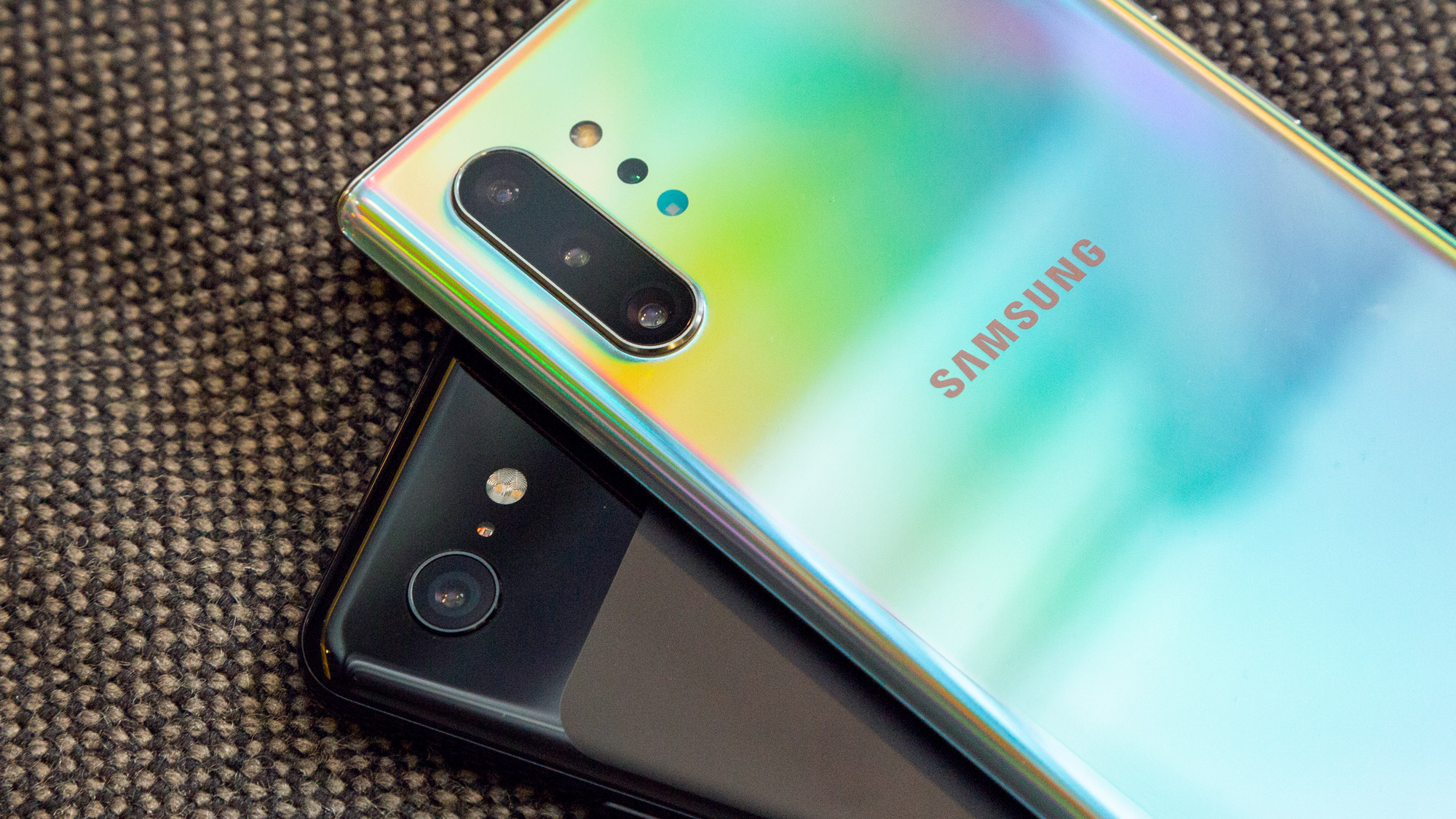Galaxy Note 10 Plus vs. Pixel 3 XL Camera Face-Off: It’s Not Even Close
Are four lenses are better than one?

While many prospective smartphone buyers will consider picking up Samsung’s shiny new Galaxy Note 10 Plus for its massive display, S Pen stylus and gaming capabilities, some will decide whether to buy Samsung’s latest phone based on how its four-lens camera system performs.
The Note 10 Plus pairs wide-angle and ultrawide optics with a telephoto lens for optical zoom, as well as a depth-aware time-of-flight sensor to deliver bokeh effects. With so many cameras at the user’s disposal — all of which come boosted with Samsung’s Scene Optimizer AI technology — you’d expect the phablet to take some seriously stunning photos.
However, Google’s Pixel 3 XL, which benefits from artificial intelligence in its own right, also captures phenomenal images for a smartphone. And it only has a single 12.2-megapixel lens on the back. It’s among the best camera phones out there for a reason.
How does the Note 10 Plus fare against one of the modern benchmarks of mobile photography? We put Samsung and Google’s hardware through a multi-round shoot-out to find exactly that.
Round 1: Flowers
For the opening round, we used a 2x zoom on both the Note 10 Plus and Pixel 3 XL to close in on a patch of begonias. Samsung’s handset handles the zoom optically, using the phone’s 12-MP, f/2.1 telephoto lens. The Pixel, meanwhile, is forced to close in digitally, using Google’s Super Res Zoom algorithm to keep the image looking as crisp as possible.
The result is surprising. You’d expect the Note to run away with this one, given that it has the advantage of optical zoom. Yet I suspect the Pixel’s post-processing isn’t hammering on the softness the same way Samsung’s phone is. Additionally, Google’s handset plainly retains more detail and color information in the highlights, whereas the glistening texture of the petals is rendered fuzzy through the Note’s lens. The unnaturally warm cast doesn’t do Samsung’s device any favors, either.
Winner: Pixel 3 XL
Round 2: Inside the library
Inside the iconic New York Public Library, we were able to test both handsets’ indoor performance and ability to deal with intense light sources. Straight away, it’s easy to see the Note 10 Plus exposes the entirety of the frame more brightly, illuminating the deepest shadows within the wooden walls as well as the hallways in the distance. The Pixel 3 XL’s shot is much dimmer by comparison, though I prefer its more pronounced contrast.
What’s particularly impressive here is the way the Note manages the highlights from the fake candles and the large window above. Google’s phone can’t rein those areas in as effectively, which leads to blowouts and other inconsistencies (like how it rendered the light striking the ceiling in an overly cool blue). Although Samsung’s handset didn’t produce a perfect result, its photo is more well-balanced overall.
Winner: Galaxy Note 10 Plus
Round 3: Group portrait
In Bryant Park, Tom’s Guide editor-in-chief Mark Spoonauer captured portraits of my colleague Kate and I using the Note 10 Plus and Pixel 3 XL. Shallow depth-of-field shots with bokeh have never been Samsung’s strong suit, though the new phablet appears to have improved somewhat in that regard, likely thanks to its new depth-mapping sensor.
If you generally prefer smoother portraits, you may appreciate what the Note turned in here. Everything from skin tone, to hair, to the fabric of our clothes is visibly softer through Samsung’s lenses. The Pixel’s shot, meanwhile, exhibits sharper details, more vivid color and stronger contrast. Google’s software generates more consistent bokeh and better separation between the foreground and background, while Samsung’s clearly had trouble determining whether the vines behind me should be blurred or not. Even after several years of developing its Live Focus mode, it appears Samsung still has some catching up to do when it comes to portraits.
Winner: Pixel 3 XL
Round 4: Outside the library
Stepping outside the library for a breath of fresh air, I captured two images using each device, with wildly different results. Again, I’m impressed with the Note 10 Plus’ ability to uncover the shadows here. As you zoom in, you can make out the very words scrawled on the building’s stone walls, which is impressive.
However, this is one of those cases where I feel Samsung is prioritizing brightness over realism, to demonstrate the magic its post-processing technology can pull off. Forced to choose between the two, I’m more drawn to the Pixel 3 XL’s natural colors and the strength of its contrast. Looking at the Note’s rendition, there’s a flatness to the leaves on the tree at the right of the frame; meanwhile, Google’s handset renders those same leaves with a sense of volume. The Pixel’s lens yielded the more authentic shot, so it gets the nod here.
Winner: Pixel 3 XL
Round 5: Cupcakes
Turning both phones to a box of cupcakes for an obligatory food shot, it’s immediately clear the Note 10 Plus takes a lot of liberties with the tint and saturation of this scene. Compared to the Pixel 3 XL’s rendition, the Note’s colors are simultaneously subdued, bright and warm.
The heavy-handed post-processing can likely be explained by Samsung’s Scene Optimizer feature, which uses AI to identify the subject of an image, and then tunes the camera appropriately to bring out the details it thinks you want to see. While Scene Optimizer can be useful in emulating the filters you often see used in apps like Instagram and VSCO, it doesn’t do this particular photo op any favors. The specular highlights and texture of the pink cupcake’s icing and sugars are glossed over by Samsung’s algorithms, and the loss of color makes the confection look considerably less appetizing.
Winner: Pixel 3 XL
Round 6: At the bar
Again, there are aspects of the Note 10 Plus’ attempt here that I like. If you zoom into the back of the bar, you notice there’s less noise in the image from Samsung’s phablet. But once again, we’re looking at a situation where the Note goes too far trying to paint a dramatic scene. This time, the result is exceedingly warm in comparison to the Pixel 3 XL’s more measured approach.
Furthermore, while the noise reduction has cleaned up the Note’s shot somewhat, there is a downside. Samsung’s algorithms have chipped away at the crispness of the finer details, like the labels on the bottles on the shelves. This isn’t surprising; noise reduction is a double-edged sword, and a certain degree of grain can serve a purpose. An ideal image might have blended the Note’s low-light sensitivity and general cleanliness with the Pixel’s superior white balance and fidelity.
Winner: Pixel 3 XL
Round 7: In the studio
To test out the Note 10 Plus’ super-low-light chops, we headed into our video studio and turned the lights off. Using the Samsung's Bright Night setting and Night Sight on the Pixel 3 XL, we were able to capture a pair of pretty stunning images considering the circumstances. You'd never be able to tell, but there was little to no light present in the room at the time we snapped both photos.
While the Pixel's take is brighter and incorporates more vivid colors, I actually think the Note's more subdued, slightly warmer tones give it the edge here. Google's Night Sight-aided attempt looks artificially illuminated, like from a flash, and I don't get that sense looking at the Samsung-produced shot. That said, it would have been nice if the Note borrowed some cues from the Pixel's sharpness.
Winner: Galaxy Note 10 Plus
Round 8: Street at night
Outdoors, we can see the full scope of what Samsung and Google’s night modes are capable of. At first glance, the Note 10 Plus’ attempt appears crisper. But when you zoom in, it’s clear to see the software is emboldening darker areas and the edges of objects — something the Pixel 3 XL doesn’t do.
In fact, Google’s Night Sight technology successfully manages to brighten and better expose the overall frame without making things look overprocessed. The Pixel’s shot isn’t perfect; there’s a tinge of a green cast at play, and the phone blows out some highlights in the trees and lights. Yet the difference in detail is so vast, and so titled in Google’s favor, that the Note loses out here — even if it gets certain respects right.
Winner: Pixel 3 XL
| Header Cell - Column 0 | Galaxy Note 10 Plus | Pixel 3 XL |
|---|---|---|
| Flower | Row 0 - Cell 1 | X |
| Rotunda | X | Row 1 - Cell 2 |
| Group Portrait | Row 2 - Cell 1 | X |
| Library | Row 3 - Cell 1 | X |
| Cupcakes | Row 4 - Cell 1 | X |
| Bar | Row 5 - Cell 1 | X |
| Studio (Night) | X | Row 6 - Cell 2 |
| Street (Night) | Row 7 - Cell 1 | X |
| Total | 2 | 6 |
Overall Winner: Pixel 3 XL
The results are in, and they're unfortunately not encouraging for Samsung. The Note 10 Plus' quartet of cameras take serviceable shots, but the Pixel 3 XL's superior processing has won us over yet again.
Google’s handset simply seems to have a better sense of when and where to apply its computational photography expertise in every photo op. The Pixel's shots never looked overexposed or garishly colored during our testing — just optimized to look as good as we think they should, based on what we see in reality. Conversely, the Note goes too far too much of the time, though at least its Scene Optimizer tech can be turned off.
Worryingly for Samsung, the company’s fortunes don’t look to improve in the near future. Google is due to unveil its Pixel 4 soon, and Apple’s iPhone 11 is coming in just a few weeks time. If the Note 10 Plus already falls behind 2018’s best camera phones, what chance does it have against Apple and Google’s next-generation hardware still to come this year?
We’ll have to wait and see, though you can look forward to comparisons between Samsung’s phablet and those devices in the coming months.
Sign up to get the BEST of Tom's Guide direct to your inbox.
Get instant access to breaking news, the hottest reviews, great deals and helpful tips.
Adam Ismail is a staff writer at Jalopnik and previously worked on Tom's Guide covering smartphones, car tech and gaming. His love for all things mobile began with the original Motorola Droid; since then he’s owned a variety of Android and iOS-powered handsets, refusing to stay loyal to one platform. His work has also appeared on Digital Trends and GTPlanet. When he’s not fiddling with the latest devices, he’s at an indie pop show, recording a podcast or playing Sega Dreamcast.
